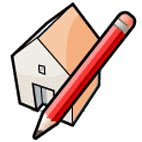Català - Castellano
Do you manually model all the curved parts of your buildings? Stop doing so. Rhino can do it for you. Let's imagine that we want to draw a curved window. We could create the curved mullions, glass, etc, or we can simply use the FlowAlongSrf command. Let me show you what this command does.
We will try to make a curved storefront following a given curve, divided in 4 parts vertically and 5 horizontally. Instead of trying to manually model it we create a flat version of it. See the image below.

To make the final result easier to handle, be sure that you Group the Storefront Mullions together. Once you have them grouped, you need to extrude the curve to the height you want the store front to be. After that you need to create a plane that matches the size of the flat store front that you have created. Something like the image below.

After we have this, everything is ready. Select the flat storefront. Type FlowAlongSrf. Select the plane near the flat storefront as base surface and select the curved surface as the target surface. These are the results.

The command FlowAlongSrf really makes modelling of curved façades much easier. See some other examples of what you can achieve with it, both based on the same 5 x 4 module.
Show me more...


























